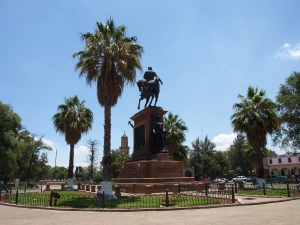By Liliana Rodriguez
Before the Spanish Conquer, the region that is now Morelia was known as Guayangareo valley and it was inhabited by a native group called the pirindas. The city was founded in 1541, but it received de name of Valladolid until 1577. In 1582, it replaced Patzcuaro as Capital of the Province of Mechoacan.
During the 17th century Morelia experienced a period of growth and development; the convents of San Francisco and San Agustin were built during the first years, then the ones of El Carmen, La Merced and other important churches. In 1660, the construction of the cathedral began. Its location defined the composition and distribution of the city. However, the big construction period happened in the 18th century, when the most beautiful civic and religious monuments of the city were built.
The convents of Las Rosas, Las Monjas and Capuchinas, were built around 1750, along with the temple of San Diego and other churches.

In 1744, the towers and façade of the cathedral were finished. This century was the most splendid period of the city’s civic architecture, due to the construction of many government buildings (Colegio Seminario, Colegio de los Jesuitas, Colegio de San Nicolás, Las Casas Reales, La Alhóndiga, etc).
In order to provide public services to the city, the squares were decorated with fountains and the aqueduct (with 253 cantera stone arcs) was built ordered by bishop Fray Antonio de San Miguel.
The first conspiracy for Mexico’s Independence war took place in this monumental city.
September 12th, 1828, the city was named Morelia after the famous José María Morelos y Pavón, who fought in the Independence War and was born in this place.
UNESCO officially proclaimed Morelia’s downtown as World Heritage in December, 1991.
Geographic Context
Morelia is the beautiful colonial capital city of the state of Michoacan. It’s located in the Mexican southwest part. It has around 1.199,02 square kilometers.
The city has two rivers known as Río Chiquito (little river) and Río Grande (big river) and it’s surrounded by Punhuato and Quinceo mountains. The weather in Morelia is mainly warm with a rain season that comes during summer. The average temperature is 20ºC.
Gastronomy
The most typical dishes of Morelia are the enchiladas, the capirotada, ates, laminillas, cocadas, jelly, hot chocolate and natural fruits.
Art Crafts
Pottery, basketwork, pieces made with cantera stone, iron works, table clothes and blouses are the main art crafts offered in Morelia.
Economic Context
The main economic activities of the city are commerce and tourism, although there are few industries: edible oil, flour, plastic, metal smelting, canned candy, water and soda bottling.
According to INEGI, the economic activities in Morelia are divided in:
– Primary sector (agriculture): 6.64%
– Secondary sector (industry): 25.91%
– Tertiary sector (commerce and tourism) 63.67%
The other 3.77% are non specified activities.



